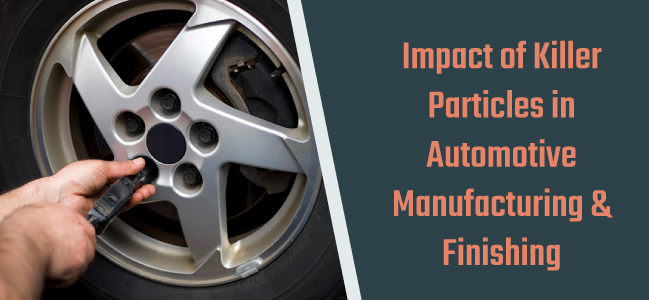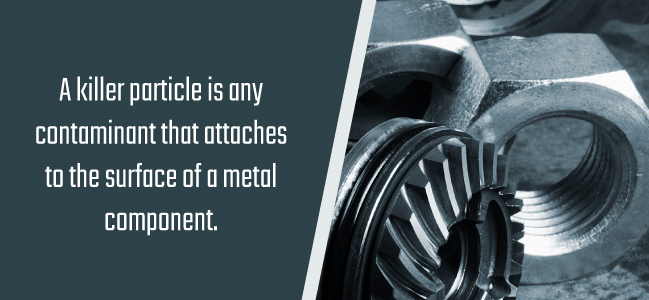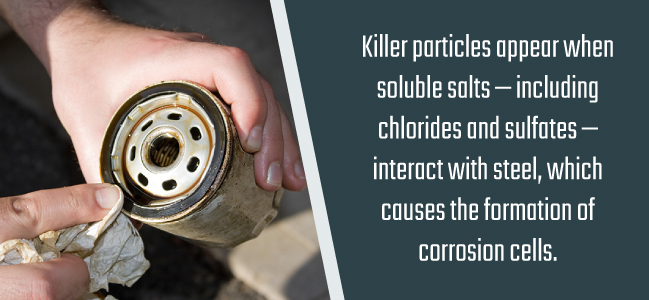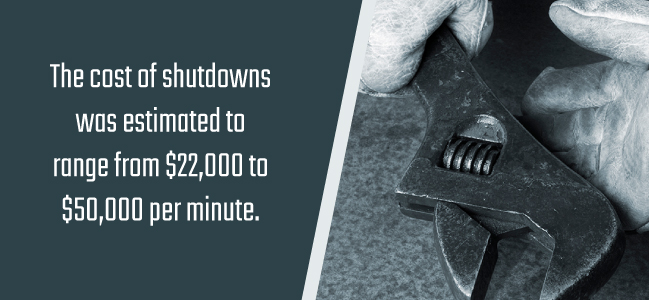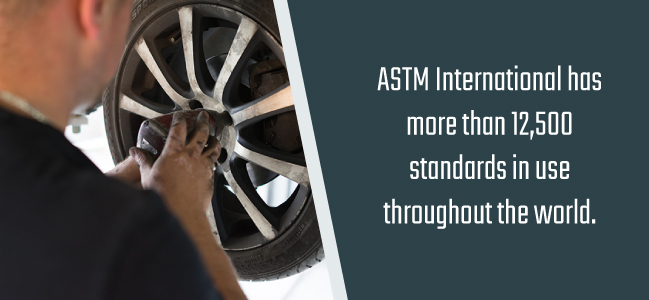Automotive parts cleaning is one of the most crucial steps in the process of vehicle manufacturing. Unfortunately, it often gets overlooked. You should always thoroughly clean car parts before plating them.
Vehicle manufacturers protect their cars, vans and trucks from killer particles by plating automotive parts. However, preparing car parts for plating is a crucial step in the process, as this prevents chemicals from bonding to metal surfaces that could allow contaminants to spread. Therefore, any preparation for car parts must include these steps, done in the proper order, to ensure killer particles don’t degrade vehicle parts.
What is a Killer Particle?
A killer particle is any contaminant that attaches to the surface of a metal component. The killer particle has detrimental effects on the quality of the surface in the physical — and sometimes the chemical — sense.
Killer particles can come from a variety of sources. They may land on the exposed metal surfaces of an automobile if it becomes exposed to the elements. However, killer particles can also bond to the surfaces of parts during the manufacturing and finishing stages of automobile production.
Killer particles can, and often do, have a detrimental effect on the ability of coats and paints to adhere to metal surfaces. Moreover, killer particles seriously undermine the protective properties of metal coatings. If not removed from the surface of an affected metal, these particles can severely degrade the integrity of both exterior and interior vehicle components.
In some cases, a contaminant will cause a reaction with metal along a particular spot along a surface, and this can serve as a breeding ground for corrosion. In any case, reactions between killer parts and metal surfaces degrade the quality of surfaces and lead to the earlier expiration of automotive parts.
What Are Common Killer Particles Found in the Automotive Manufacturing Process?
Killer particles come from many different sources, and their effects can differ depending on their origin and the surface they land on. They often, however, appear during manufacturing. Some of the most common contaminants that are known to occur in the automotive manufacturing process include the following:
- Soluble salts, which can transfer through the air in vapor form — this is especially common in coastal areas.
- Oil and grease compounds, which often get distributed across metal surfaces at pressing plants via aerosolized particulates from pneumatic tools.
- Residual adhesives, which bond to metal surfaces when adhesive products, such as tape or plastic, are applied.
- Mineral contamination, which often comes from hard water.
- Stray currents, which sometimes bring killer particles into process solutions when the electrolytic process is underway.
Particles may spread to uncoated parts from workers’ hands or surfaces that workers place the parts on. If the parts are wet, placing them on brown Kraft paper can make them more likely to collect killer particles.
Soluble salts are one of the most common killer particles. Spread in both industrial and atmospheric environments, soluble salts originate from acid rain and pollution and also spread to metal surfaces via chemical processes and immersion.
Killer particles appear when soluble salts — including chlorides and sulfates — interact with steel, which causes the formation of corrosion cells. It only takes a tiny amount of these particles to spark this process on a metal surface, which leads to the degradation of the physical properties of metal surfaces.
In cases where soluble salts make their way between two layers of metal coating, osmotic blistering can occur that leads to further breakdown along the surfaces of automotive parts. When moisture makes it way under the coating to form blisters, pressure accumulates along the surface. Moisture and chlorides react with one another, and this leads to the formation of corrosion cells.
You can use testing kits to scan the surfaces of metal parts to verify whether killer parts have bonded to them. In particular, these kits are used to look for the presence of acidic and alkaline particles. Workers often perform these analyses on metal surfaces where contamination has already become evident at the macroscopic level. However, manufacturers might also perform these tests on newly made metal parts before they leave the factory.
In many cases, the contamination of metal surfaces can is preventable. However, if prevention is not possible, impurities can still be removed from a metal surface. Some of the more common methods of particle removal include:
- Blasting, wire brushing, or the use of mechanical devices to remove killer particles from metal.
- Electropolishing, which utilizes an electrochemical approach to the removal of killer particles.
- Chemical processes, such as pickling, passivation, or the use of chelating products to remove contaminants from surfaces.
- Washing and drying, a simpler process that involves solvents with the power to cut through killer particles.
In some cases, degreasing compounds can also remove killer particles. In advance of an abrasive cleaning of a metal piece, chemical contaminants such as hydrocarbons and salts must be stripped from the surface. This step is also necessary before the application of metal coatings.
How Much Does it Cost Automotive Companies to Shut Down Systems Due to Killer Particles?
In a 2005 survey of 101 executives in the field of automotive manufacturing conducted by Nielsen Research, the cost of shutdowns was estimated to range from $22,000 to $50,000 per minute. Most of the respondents surveyed, which included executives across various branches of the automotive sector, from automakers to engine and parts makers, said that they would outsource the maintenance of machinery to prevent the problem.
While respondents cited the lower end of the cost spectrum ($22,000) as the typical consequence for every 60 seconds of downtime during automotive production, a handful of the executives surveyed reported costs at the high end of the spectrum. With losses in this range, the clean operation of factory machinery is paramount to the bottom line of the automotive industry.
Of the respondents in the Nielsen survey who said that they would outsource factory services if given the option, 53 percent of automotive executives cited the maintenance of production machines as the area in which they could make the most significant improvements.
With superior maintenance, breakdowns of production machinery would drastically diminish, while machine performance would be more reliable. Killer particle dispersal would also lessen significantly.
Another area of automotive production that respondents mentioned for outsourcing was tool room management, the area in which tools maintenance occurs and spare parts are stored. Here, oils and salty moisture can aerosolize and spread if workers do not adequately maintain pneumatic equipment. As such, the outsourcing of tool room management could also help reduce the prevalence of shutdowns caused by the dispersal of killer particles.
What is CQI 11?
CQI 11 is one of two self-assessments — the other being CQI 12 — that the Automotive Industry Action Group (AIAG) developed. The group designed the two assessments to promote the uniform application of high standards in the plating and coating of parts throughout the automotive industry. CQI 11 covers the area of plating processes used among automakers. Suppliers for Chrysler, Ford and GM implemented the two assessments in January 2008.
Combined, the CQI 11 and CQI 12 assessments cover each level of the automotive supply chain among participating manufacturers. The process of implementing the two evaluations occurred at a slower pace than that of the previous CQI 9, which concerns heat treat suppliers. Miscommunication among supply tiers may have contributed to this delay.
According to the principles of CQI 11, a self-assessment must cover the following steps for proper implementation:
- Buy a copy of the CQI 11 assessment from the AIAG, which comes with a CD for electronic records maintenance.
- Give out copies of the assessment to internal auditors and other concerned parties.
- Make sure that the parties responsible for the completion of the assessment have a full understanding of how the questions of CQI 11 correlate to the process tables.
- Give assignments that pose questions to the technical experts and have them offer evidence to support their answers.
- Store the information gathered from the results of the assessment in an electronic file.
- Create a list of actions to be carried out in the areas that failed the assessment, along with a deadline for the completion of such actions.
- Allow four weeks for the completion of the master assessment, and appoint auditors to go over the requirements to verify compliance.
- Carry out one or more audits of a customer’s parts that must meet the requirements of the assessment.
- Have a completed form of the assessment on file for access upon request by any customer. Some customers might insist on performing an audit of the assessment.
- If items within your assessment are found to be unsatisfactory according to the customer, you have exactly three months to rectify the issue.
- Mark the calendar each year for an annual reassessment.
A thorough assessment conducted over the course of several months is more beneficial to all parties involved than a rushed evaluation performed at the request of a customer.
What is ASTM?
The American Section of the International Association for Testing Materials (ASTM) is an international organization that publishes standards for material and product testing. Established in 1898 and headquartered in West Conshohocken, Penn., ASTM International has more than 12,500 standards in use throughout the world.
The standards put forth by ASTM International are voluntary, and the organization has no hand in the enforcement of its standards. However, ASTM standards can become law in some areas if enforced at the government level. Many companies also enforce them at the corporate level. In the U.S., the National Technology Transfer and Advancement Act of 1995 has advanced the spread of consensus standards developed by independent entities.
Automotive Parts Plating and Cleaning
Throughout the auto industry, manufacturers are always on the lookout for methods that can eliminate the effects of killer particles.
Rust is one example of a typical consequence of contamination along the surfaces of metal parts. For metal, rust formations are like weeds in a lawn — a problem that can keep spreading if you don’t address it. Rust can spread across a metal component quickly and also pass onto other nearby metal parts. Rust can ruin paint jobs and eat holes in areas of high concentration. When rust spreads along automotive exteriors and engine components, the damage can be costly and sometimes render the vehicle unsalvageable.
Rust can take root due to a variety of causes. A crack in the paint on the exterior of a vehicle serves as an opening to the underlying metal surface. Once exposed, the metal becomes vulnerable to corrosion when rainfall hits. Various external factors can cause paint cracks to form, such as age, falling branches, kicked-up debris and hail.
For all the cosmetic damage that rust can cause to the exterior of a vehicle, the worst corrosion possible is that which forms internally. When rust forms along engine components, it can cause parts to fail. Worst of all, most vehicle owners don’t realize they have internal rust until the problem becomes extensive and pricey. Fortunately, automakers can now protect the vehicles they manufacture with automotive plating.
A lot of metals are also rendered vulnerable to rust due to oversights in the manufacturing process. In cases where electroplating has failed to protect a metal part, the problem is usually the result of improper preparation of the substrate surface. Sadly, the entities in charge of such operations often overlook the importance of removing foreign particles, chemicals and oil before the metal-finishing process.
For metal automotive parts to withstand the impact of the environment and resist corrosion, the underlying surfaces must be clean and free of foreign particles in advance of any coating application. At Sharretts Plating Company (SPC), we specialize in automotive plating and parts cleaning. For cleaner and more durable metal on your automotive parts, submit a request for a quote from SPC today.


